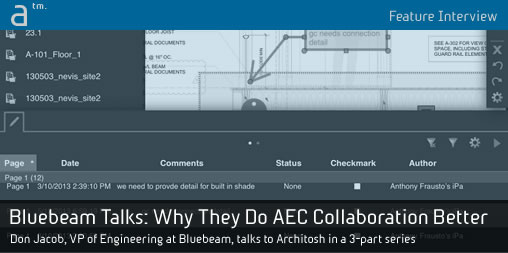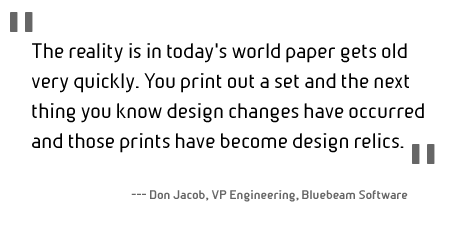Back in the spring I got a chance to talk to Don Jacob, Vice President of Engineering, Bluebeam Software, while he was attending the FIATECH Conference in Texas. He was excited and energized from that event and from the fact that the company had just released its brand new updated Revu 11 software. Of course Architosh has noted that in a news coverage piece but we had a few more questions. With that in mind, we spoke to Don to talk to us about how Bluebeam Software is addressing the pain points of modern AEC collaborative practice.
What do Saab and Bluebeam Have in Common: An Aerospace Heritage
While perhaps not as lofty a mention as it has been for the once great Swedish car manufacture, having an aerospace history is one thing Bluebeam Software shares with the car innovator. In this case originating in design and aerospace meant Bluebeam Software learned early on the value of precision.
“The primary need in the design industry ten years ago was to get high quality PDFs out of complicated CAD systems to be able to easily work with those PDFs,” said Don Jacob. “We needed to get true-to-spec output for things like line-weights, precision and maintaining fidelity to the original CAD data…these were the things that mattered in engineering design.”
Bluebeam Software may have had its beginnings in aerospace but it also learned quickly that in just about all CAD professions users wanted to be able to work with the data in the field in ways that went beyond just keeping a close ‘one-to-one relationship’ with the original source CAD data; they also learned that users wanted to share and control the information in a flexible manner. While precision and accuracy were foundational aspects of their plugin software, today Bluebeam’s larger mandate extends to the broader needs of collaboration.
A Digital Master Set
“Whether in the office or in the field, being able to collaborate on and maintain a digital master set of documents is what Bluebeam Software excels at, says Don Jacob. We asked how their software handles the “digital master set” challenge.
What Bluebeam Software does is allow users to store files, including PDFs, of their master CAD documents (drawings) within Revu’s integrated cloud solution, Studio, or hosted in-house behind their own company firewall. What is key is that the software makes it very easy for users to take the drawings they need into the field, or the remote board room, and have a conversation on those documents, while maintaining clear configuration control over the documents back on the cloud. There are two aspects to Studio actually. There is the Studio Projects side which allows users to store, check out and edit files, even if Internet connectivity is lost, and then check them back in when connectivity is restored. Studio Sessions allows users to comment on a set of documents in real time at the same time for immediate feedback or on their own time which is key as project teams become increasingly global.
“So I can take my drawings on my [Apple] iPad, go into the field and mark them up, upload those into my Studio Sessions and now the team can see them and interact with them dynamically,” says Jacob. Inside of a Studio Session multiple participants can annotate and interact with the drawings and its all recorded in the collaboration session. “So everything that happens in a Session is being recorded and tracked in a nice orderly fashion so it becomes the digital master set for the projecta,” says Jacob.
A Matter of Time: The Shelf Life Problem
If keeping all collaborative dialog and info exchange together and recorded and linked to drawings centrally stored in the cloud sounds like a dream too good to be true, there’s an even more basic problem that Revu can solve for AEC folks–keeping up with the ever increasing pace of time.
We live and construct in the same digital universe. Our demand for instant social updates and stock prices all come to bear on the realities of how we build the physical world–something that by its very nature, takes lots of time. As a result the AEC industry has harnessed the latest ‘all-digital’ tools but we still seem to carry paper in the field.
“The reality is in today’s world paper gets old very quickly,” says Jacob. “You print out a set and the next thing you know design changes have occurred and those old prints have become design relics. The company says its solutions help solve this problem by keeping that all important master set of the most current documents–including documents annotated and marked up in collaborative Sessions–all in their Bluebeam Studio cloud solution.
Integrating Well With BIM
Bluebeam’s software is PDF-based because the file format has become the lingua franca of information exchange on the Net. Yet, the company has made great strides making Revu plug into the emerging new BIM (Building Information Modeling) workflows transforming the AEC industry.
Revu 11 supports new 3D functionality (which you can read about in our recent review here) in that you can bring in snap-shot 3D images from a BIM application and mark them up. “We have plugins for Revit, Navisworks as well as support for any IFC file.” says Jacob.
If a user has an IFC file from any BIM application, you can open that file in Bluebeam Revu 11. You can create a brand new blank PDF file in Revu, open a 3D window and it will put the IFC model into that window.
“The world is in 3D and workflows are going more and more 3D with BIM,” said Jacob. “So the challenge is always, how can we leverage 3D data for users downstream? So we built tools that can very quickly pull out a subset of a BIM model and paste it into a PDF which can then be marked up.”
Better AEC Collaboration
Today the AEC industry relies on what most of the world relies on for open document exchange: Adobe’s de facto PDF. AEC pros use it often in the printing and plotting process, they use it for passing around and sharing documents, they use it for archival purposes and in many cases they use it to collaborate and go mobile.
Bluebeam Software staked out its whole strategy around PDF many years ago and it has become a wise decision. “Ten years ago it was ‘how do you get a high quality PDF out?’ ” remarks Jacob. “Five years ago it was ‘we don’t want to have to print anymore.’ That inspired Revu. And then in that process it took us downstream a bit for other users in the field for instance who wanted to be able to collaborate and markup drawings in the field.”
That evolution from the architectural practice to the consultants to the construction teams has seen Bluebeam Software explode. “People in the field can’t be waiting around for information anymore,” said Jacob. “With Revu you have the ability to manage information on multiple devices, with multiple teams and stakeholders and still easily maintain that one digital master set in the field.”
Coming Up in Part 2: Bluebeam Talks: The iPad Field Solution





Reader Comments
RT @architosh: Bluebeam Talks: Why They Do AEC Collaboration Better: Back in the spring I got a chance to talk to … http://t.co/63acsXkxaA
RT @architosh: Bluebeam Talks: Why They Do AEC Collaboration Better: Back in the spring I got a chance to talk to … http://t.co/63acsXkxaA
Comments are closed.